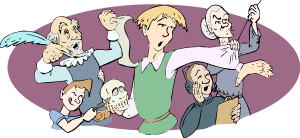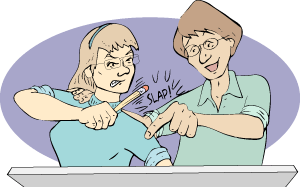The Parts of the Sum – The Art of Collaboration
Artists are notoriously temperamental and unstable creatures. So it’s inevitable that when two of them come together the explosive reaction is going to be comparable to matter and antimatter interacting. However, its up to the skills and control of the artists involved to determine if that explosion is a cheer-inspiring pyrotechnic fireworks show or an horrific explosive force that destroys them both.
I’m able to look at this kind of collaboration from a rather unique perspective. I’ve spent about 25 years working in professional theater. I’ve been a Director, a Stage Manager, a Designer, a Playwright, a Technical Director and an Actor. Each position has developed skills that I have used in my approach to producing a comic.
 In the world of theater, collaboration is an everyday fact of life. Writers present a script, which is interpreted by a director and ultimately presented by the actors. In most cases the writer isn’t around to see what’s being done with his work; and Directors are only around for rehearsals then disappear for the run of the show. They each do their part and allow the other contributors to do their parts. This kind of operation requires a lot of trust and the ability to enjoy each other’s ideas and contributions, but it’s all part of the magic of theater.
In the world of theater, collaboration is an everyday fact of life. Writers present a script, which is interpreted by a director and ultimately presented by the actors. In most cases the writer isn’t around to see what’s being done with his work; and Directors are only around for rehearsals then disappear for the run of the show. They each do their part and allow the other contributors to do their parts. This kind of operation requires a lot of trust and the ability to enjoy each other’s ideas and contributions, but it’s all part of the magic of theater.
So how do you do that? How do you “draw that line in the sand” in terms of keeping true to your own artistic vision, yet work cooperatively with someone to create a joint venture? There are rules of procedure that can be used, rules that clearly divide roles and responsibilities. This is where the examples of theater can be the most helpful.
A playwright is responsible for the words spoken, an actor is responsible for how those words are spoken and a costume designer decides what the actor is wearing when they say the words. The costume designer has no say in what the writer writes, but he or she is free to interpret the “feel” of what the writer has written as it applies to the wardrobe. While each of their contributions will influence the other, they each have clearly defined responsibilities.
In a traditional comic collaboration, with a writer and an artist, when in doubt it’s always easiest to fall back to your assigned roles. The writer is in charge of the words and the artist controls the look of the piece. That’s it. You do your part and let the other person do theirs.
While this kind of strict, “letter-of-the-law” arrangement can help ease tensions; it can also rob the collaborators of some of the greatest benefits of collaboration. What happens when the artist wants to suggest a script to the writer, or the writer wants to push the artists level of detail? How well can the artists take this kind of constructive criticism? If these attempts to help each other are ignored as “not your job” then some great opportunities can be lost. This is where the “give and take” of collaboration is put to the test.
 It’s one thing to collaborate with each person taking a specific writer/artist/colorist role. But what happens in a full crossover where two artists, who are king of the domains of their own strips, try to work together to bring their strips together in a cross over? Not only are each of them use to commanding each aspect of their own creative process, but they’re putting their characters and their comic universe on the table for the other creator to come play in. What if one artist doesn’t like the way another artist draws his characters? What if a writer wants to present opinions that the artist doesn’t agree with? How do you keep your beloved creations from being bastardized by this collaborating interloper?
It’s one thing to collaborate with each person taking a specific writer/artist/colorist role. But what happens in a full crossover where two artists, who are king of the domains of their own strips, try to work together to bring their strips together in a cross over? Not only are each of them use to commanding each aspect of their own creative process, but they’re putting their characters and their comic universe on the table for the other creator to come play in. What if one artist doesn’t like the way another artist draws his characters? What if a writer wants to present opinions that the artist doesn’t agree with? How do you keep your beloved creations from being bastardized by this collaborating interloper?
Once again it’s easy to draw creative lines in the sand and put each creator in his place. The most extreme approach to this, and still fall under the definition of a crossover, would be a story structure that incorporates some kind of connecting theme, but no real interaction between the characters (much like the old “Love Boat” or “Fantasy Island” episodes). Each artist can create separate stories that only marginally overlap.
While this can create a dispute-free interaction, it once again robs the creators and the audience of the thrill of seeing unassociated, but familiar, characters interacting and new artistic interpretations of their favorite strips by a different favorite artist. This is what people want to see, this is where the magic of artistic interaction really takes place; this is a true collaboration. And like any art form, much of its success can be measured by the participants’ willingness to skillfully ignore the rules without having it blow up in your face.
It’s not easy. Most creators have a pretty intimate relationship with their creations and the fear of getting caught up in something disastrous can be terrifying. The only thing scarier than bearing your soul artistically is to let someone else play with your creative expression.
In theater creative elements clash all the time, for example the costume designer wants to use bright warm colors but the set designer wants muted cools. But in that case, there’s always a director to step in and unify the vision of the team. A comic collaboration rarely has this kind of definitive hierarchy, everyone’s equal. But most comic collaborations only involve a couple of people, not the masses involved in a theater production. Even though there isn’t a directorial hierarchy, it should be easier for two people to work together. But it’s up to those two people and their interaction skills to pull it off.
There are a huge number of ways collaborations can be approached. Each team is different and is going to have different needs; finding those needs is rarely easy. Figuring out how to work together can end up becoming kind of an art form within an art form. There are rules and procedures that can be used to keep collaboration civil, but it’s when artists can set aside their egos and ignore those guidelines that collaborations really become greater than the sum of their parts.
In the end it’s a gamble, you may be putting your trust in a partner who’s going to let you down, it probably won’t end up going the way you thought it would. But like any gamble, the biggest payoff will come when put in all the chips. So trust your collaborator and let yourself enjoy their contribution, just let go and see what develops.
Mark Mekkes is the creator of Zortic and the co-creator, with Tiffany Ross of Abby’s Agency.
Recent Comments